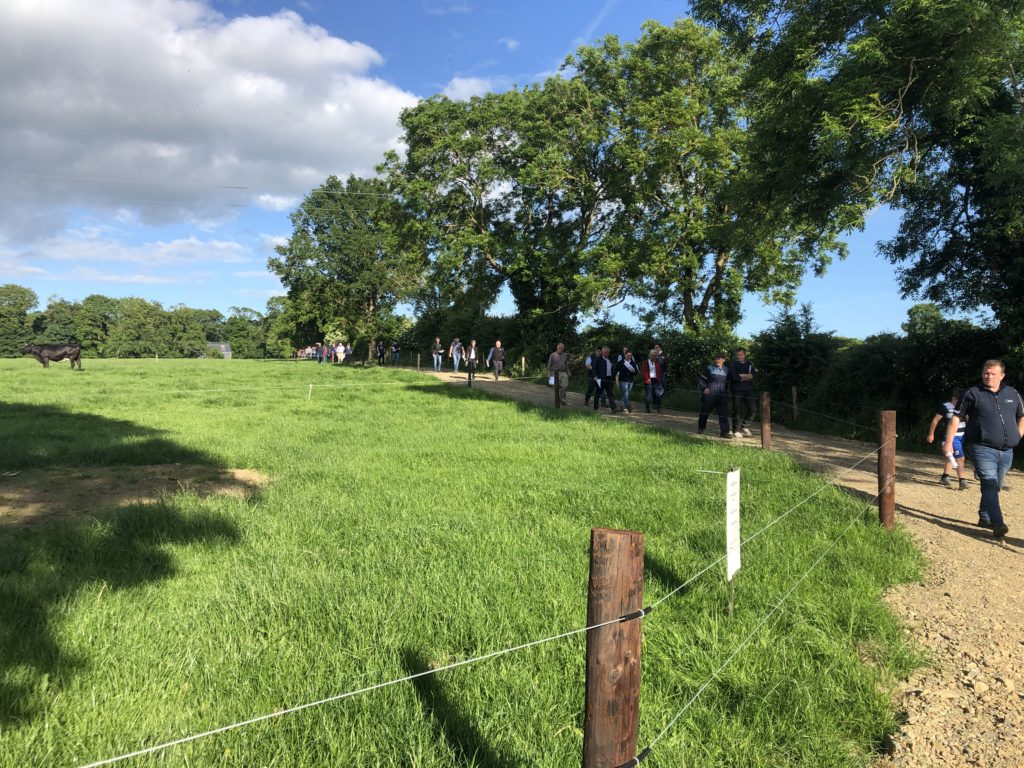The Irish Grassland Association (IGA) held a beef event on Tuesday evening (June 14) in Ballyhale, Co. Kilkenny, on the farm of Jimmy Madigan.
The event was exceptionally well attended, with large numbers of beef and suckler farmers from both near and far turning up on the evening for the farm walk.
Weather conditions proved favorable, as the rain held off for the IGA event despite temperatures turning cooler later in the evening.
The mood among beef farmers at the event was fairly positive in light of the strong cattle trade at present.
However, there was a noticeable level of concern among beef finishers at the event regarding whether winter-finishing cattle will be financially feasible this year in light of colossal increases in input costs.
Attendees at the event heard a full overview of the host Jimmy Madigan’s farming system, and were given the opportunity to ask questions on different elements of the farm.



One of the stops on the farm walk was in a reseeded field which contained a high level of clover.
Nitrogen
Speaking at the event, Teagasc research officer James Humphreys said: “If we look at where nitrogen (N) comes from to grow grass, we often overlook the capacity of the soil itself to supply nitrogen.
The Teagasc advisor told the IGA event attendees: “All soils have the ability to supply nitrogen to grass; if we look at grass growth on a lawn, it’s a classic example.
“Typically, it’s around 150kg of N/ha/year. The biggest way we can influence that is through spreading lime.”
The host, farmer Jimmy Madigan added: “Reseeding is a great investment, the money is really not spent at all. The way I look at it is, if I don’t reseed, eventually I’d go out of business.”
Host farmer
Farmers heard how Jimmy has planned to cease spreading nitrogen fertiliser on this 5ac bloc of ground and let the clover in the newly-reseeded sward trap atmospheric nitrogen to supply adequate levels of N fertiliser to the field.
Jimmy explained that the 5ac paddock was sprayed off on March 26, and was reseeded on April 23, this year.
Before sowing, the field received 2t/ac lime followed by three passes of a disc harrow.
Three bags/ac of 13:6:20 fertiliser with sulphur was then applied and the seed was sown with a one-pass sower at a rate of 1.2 bags/ac.
Finally, the field was rolled and a post-emergence spray was applied five weeks after sowing. The field was grazed seven weeks after sowing.
Each 1ac bag of grass seed contained 2kg white clover (AberSwan and Aberherald), 10kg of perennial ryegrass and 2kg red clover. The 5ac paddock received a total of six bags of seed.
Humphreys noted that including the red clover was “unusual”, but said trials in Solohead have found red clover to be “very efficient in terms of rapid establishment of the sward”.
He explained that when examining a clover sward, “you’re looking for root nodules that take atmospheric nitrogen and convert it into a plant available form”.
Jimmy said there were no issues with clover establishing in the sward and the evidence of this was on display for attendees to see at the farm walk.



Teagasc’s James Humphreys recommended 0.5 bags/ac of 0:7:30 fertiliser after every grazing or slurry. Jimmy said that towards the back-end of this year, he plans to target it with slurry.
On the evening of the IGA farm walk, Jimmy’s spring-calving suckler herd were out grazing the new reseed.
Next spring, Jimmy plans to apply two bags/ac of 10:10:20 and after that, the ground will be receiving “no chemical nitrogen any more”.
